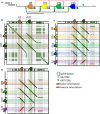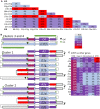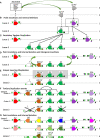Sequence Diversity, Locus Structure, and Evolutionary History of the SpTransformer Genes in the Sea Urchin Genome
- PMID: 34867968
- PMCID: PMC8634487
- DOI: 10.3389/fimmu.2021.744783
Sequence Diversity, Locus Structure, and Evolutionary History of the SpTransformer Genes in the Sea Urchin Genome
Abstract
The generation of large immune gene families is often driven by evolutionary pressure exerted on host genomes by their pathogens, which has been described as the immunological arms race. The SpTransformer (SpTrf) gene family from the California purple sea urchin, Strongylocentrotus purpuratus, is upregulated upon immune challenge and encodes the SpTrf proteins that interact with pathogens during an immune response. Native SpTrf proteins bind both bacteria and yeast, and augment phagocytosis of a marine Vibrio, while a recombinant SpTrf protein (rSpTrf-E1) binds a subset of pathogens and a range of pathogen associated molecular patterns. In the sequenced sea urchin genome, there are four SpTrf gene clusters for a total of 17 genes. Here, we report an in-depth analysis of these genes to understand the sequence complexities of this family, its genomic structure, and to derive a putative evolutionary history for the formation of the gene clusters. We report a detailed characterization of gene structure including the intron type and UTRs with conserved transcriptional start sites, the start codon and multiple stop codons, and locations of polyadenylation signals. Phylogenetic and percent mismatch analyses of the genes and the intergenic regions allowed us to predict the last common ancestral SpTrf gene and a theoretical evolutionary history of the gene family. The appearance of the gene clusters from the theoretical ancestral gene may have been driven by multiple duplication and deletion events of regions containing SpTrf genes. Duplications and ectopic insertion events, indels, and point mutations in the exons likely resulted in the extant genes and family structure. This theoretical evolutionary history is consistent with the involvement of these genes in the arms race in responses to pathogens and suggests that the diversification of these genes and their encoded proteins have been selected for based on the survival benefits of pathogen binding and host protection.
Keywords: Strongylocentrotus purpuratus; gene family evolution; invertebrate immunity; large gene families; sea urchin.
Copyright © 2021 Barela Hudgell and Smith.
Conflict of interest statement
The authors declare that the research was conducted in the absence of any commercial or financial relationships that could be construed as a potential conflict of interest.
Figures









Similar articles
-
Recombinant SpTransformer proteins bind to specific sites on sea urchin phagocytes and modulate SpTransformer gene expression and immune responsiveness.Front Immunol. 2025 Jan 28;15:1496832. doi: 10.3389/fimmu.2024.1496832. eCollection 2024. Front Immunol. 2025. PMID: 39936151 Free PMC article.
-
SpTransformer proteins from the purple sea urchin opsonize bacteria, augment phagocytosis, and retard bacterial growth.PLoS One. 2018 May 8;13(5):e0196890. doi: 10.1371/journal.pone.0196890. eCollection 2018. PLoS One. 2018. PMID: 29738524 Free PMC article.
-
Recombinant SpTransformer proteins are functionally diverse for binding and phagocytosis by three subtypes of sea urchin phagocytes.Front Immunol. 2024 Apr 29;15:1372904. doi: 10.3389/fimmu.2024.1372904. eCollection 2024. Front Immunol. 2024. PMID: 38742116 Free PMC article.
-
The SpTransformer Gene Family (Formerly Sp185/333) in the Purple Sea Urchin and the Functional Diversity of the Anti-Pathogen rSpTransformer-E1 Protein.Front Immunol. 2017 Jun 30;8:725. doi: 10.3389/fimmu.2017.00725. eCollection 2017. Front Immunol. 2017. PMID: 28713368 Free PMC article. Review.
-
Sp185/333: a novel family of genes and proteins involved in the purple sea urchin immune response.Dev Comp Immunol. 2010 Mar;34(3):235-45. doi: 10.1016/j.dci.2009.10.008. Epub 2009 Nov 12. Dev Comp Immunol. 2010. PMID: 19887082 Review.
Cited by
-
The complex set of internal repeats in SpTransformer protein sequences result in multiple but limited alternative alignments.Front Immunol. 2022 Oct 18;13:1000177. doi: 10.3389/fimmu.2022.1000177. eCollection 2022. Front Immunol. 2022. PMID: 36330505 Free PMC article.
-
Recombinant SpTransformer proteins bind to specific sites on sea urchin phagocytes and modulate SpTransformer gene expression and immune responsiveness.Front Immunol. 2025 Jan 28;15:1496832. doi: 10.3389/fimmu.2024.1496832. eCollection 2024. Front Immunol. 2025. PMID: 39936151 Free PMC article.
-
Local Genomic Instability of the SpTransformer Gene Family in the Purple Sea Urchin Inferred from BAC Insert Deletions.Genes (Basel). 2024 Feb 9;15(2):222. doi: 10.3390/genes15020222. Genes (Basel). 2024. PMID: 38397211 Free PMC article.
-
Innate Immunity Mechanisms in Marine Multicellular Organisms.Mar Drugs. 2022 Aug 25;20(9):549. doi: 10.3390/md20090549. Mar Drugs. 2022. PMID: 36135738 Free PMC article. Review.
-
Lipofection mediated transfection fails for sea urchin coelomocytes.PLoS One. 2022 May 6;17(5):e0267911. doi: 10.1371/journal.pone.0267911. eCollection 2022. PLoS One. 2022. PMID: 35522665 Free PMC article.
References
Publication types
MeSH terms
LinkOut - more resources
Full Text Sources
Miscellaneous

